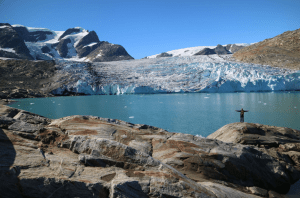Anahita Kodali, Physical Sciences, News, Summer 2020
Image 1: This is the Greenland’s Hann Glacier. It, along with Greenland’s other glaciers, has been threatened by ice melt.
Image Source: Wikimedia Commons
In recent years there is a growing urgency to halt the Arctic ice melt – and for good reason. The ice melt has significant effects on the rest of the globe, including the majority of the planet that lies outside of polar regions. For one, the ice melt contributes to a rise in global sea levels, endangering costal and island communities. Secondly, the loss of ice contributes to a destabilization in global temperature. Ice reflects heat back out of the atmosphere because it is shiny; when ice melts, less heat is reflected and more will be absorbed into Earth, leading to a rise in temperatures. Changes in heat cause disruptions to the polar jet stream, which is a wind that circles the Arctic regions; the stream relies on the stark temperature differences between Arctic regions and the rest of the world to be stable, so as the temperature of the Arctic rises as ice melts, the jet stream becomes much less stable, causing more extreme winters around the globe. Thirdly, the Arctic ice and permafrost contain high levels of methane; when they melt, this methane is released into the atmosphere, contributing to heightened greenhouse gas effects. There are also several indirect impacts on food sources, shipping paths, and wildlife.1 Thus, stopping the ice melt is critical to addressing several of the issues that humans and our ecosystems are experiencing due to climate change.
Unfortunately, researchers from Ohio State University have found that Greenland’s glaciers have passed a point of no return when it comes to ice loss; the winter snows that reverse the melting of the ice sheets every year will not be able to make up for the loss of ice due to rising temperatures. The team used satellite imaging data to study over 200 glaciers that surround Greenland from the 1980s to the 2010s. They found that during the 80s and 90s, the amount of ice lost during the year was kept in check by winter snowfalls. The ice was in equilibrium. However, during the 2000s, the amount of ice loss began to increase rapidly, resulting in an “ice deficit” that snowfall could not make up for. Now, even if global warming was somehow stopped immediately and temperatures stayed constant, the loss of ice would not be made up for by the snowfall for a significant period of time.2
These findings do not bode well for the future of the planet. However, Michaela King, researcher at Ohio State University’s Byrd Polar and Climate Research Center and the study’s lead author, said that there are some positives. King explains that “it’s always a positive thing to learn more about glacier environments, because we can only improve our predictions for how rapidly things will change in the future.”3 This study, while bleak, will allow us to be better prepared for what the future holds and perhaps give us more insight into how we can stop Arctic ice melt in the future.
References
[1] Hancock, L. Six ways loss of Arctic ice impacts everyone. WWF. https://www.worldwildlife.org/pages/six-ways-loss-of-arctic-ice-impacts-everyone.
[2] King, M. D., Howat, I. M., Candela, S. G., Noh, M. J., Jeong, S., Noël, B. P. Y., … Negrete, A. (2020). Dynamic ice loss from the Greenland Ice Sheet driven by sustained glacier retreat. Communications Earth & Environment, 1(1).https://doi.org/10.1038/s43247-020-0001-2
[3] Ohio State University. (2020, August 13). Warming Greenland ice sheet passes point of no return: Even if the climate cools, study finds, glaciers will continue to shrink. ScienceDaily. Retrieved August 15, 2020 from www.sciencedaily.com/releases/2020/08/200813123550.htm
